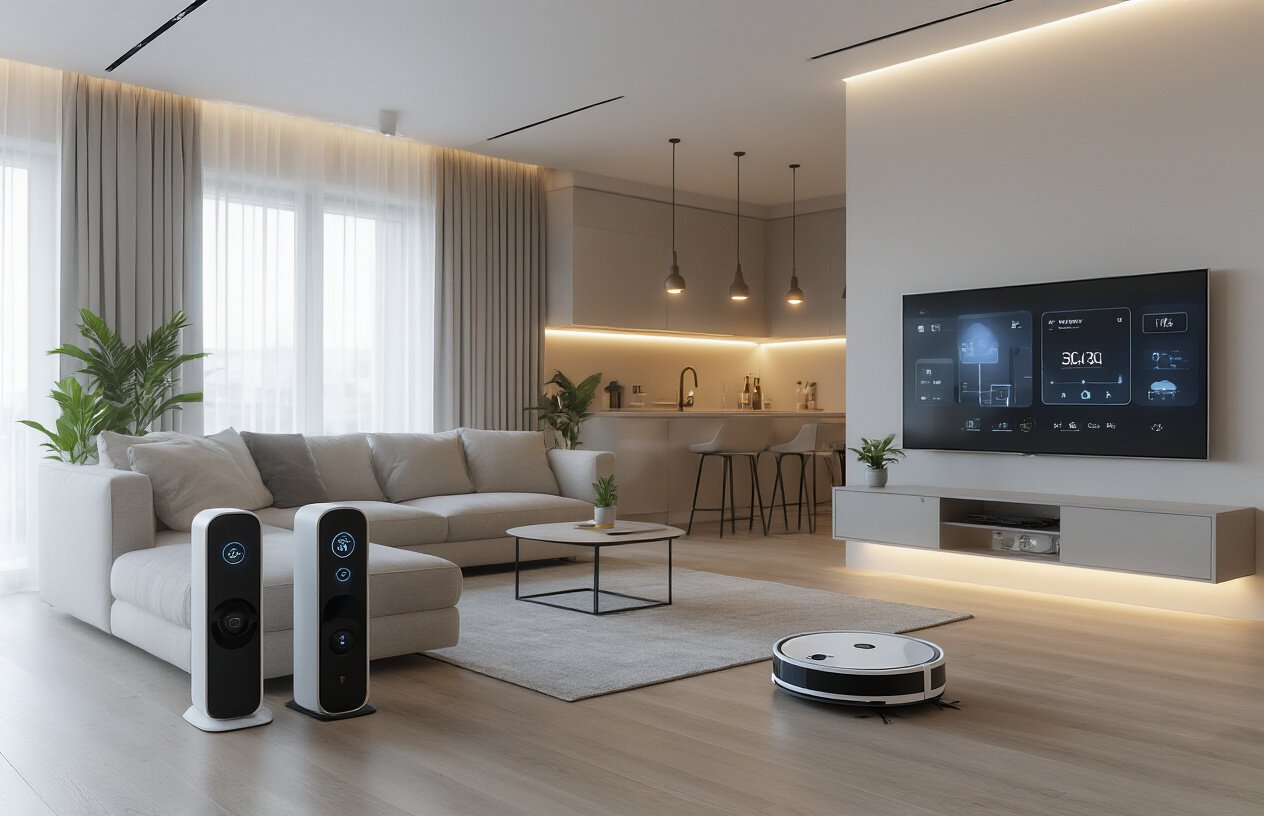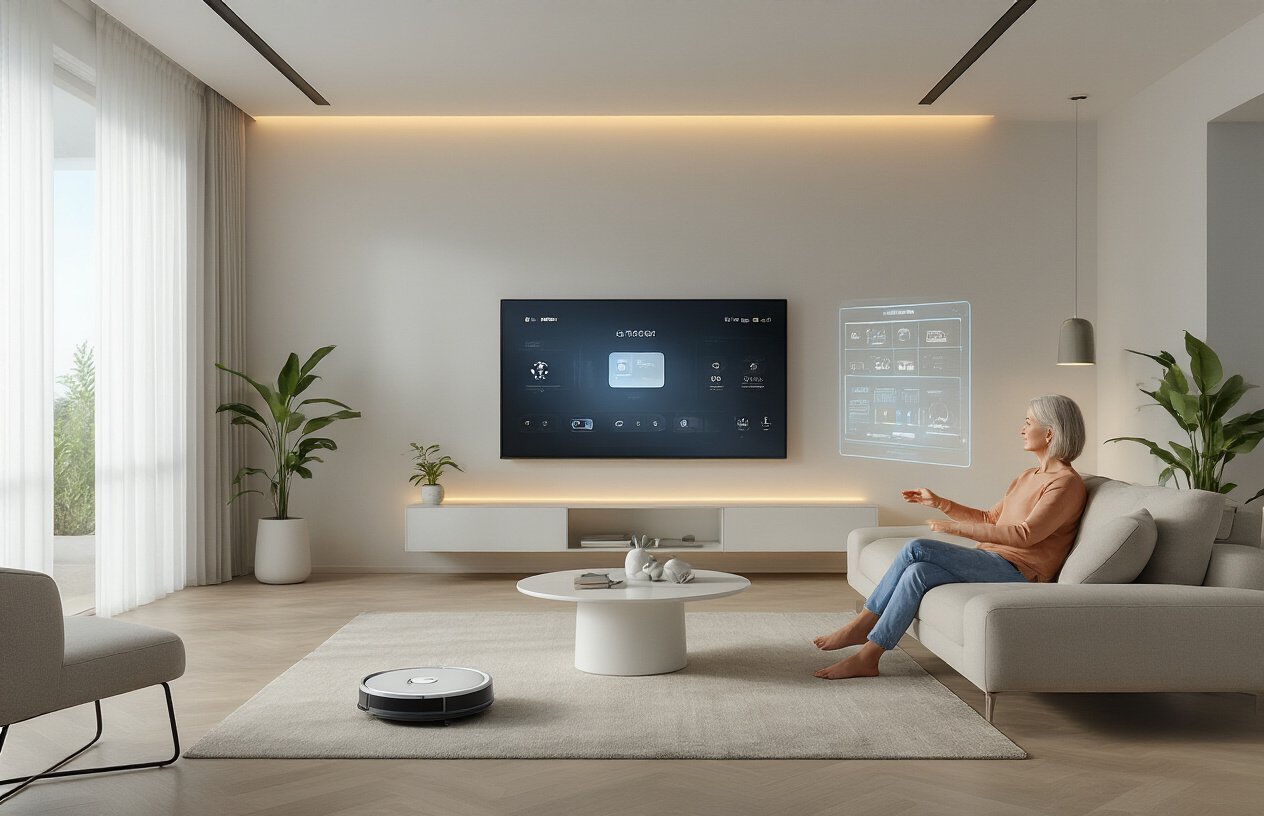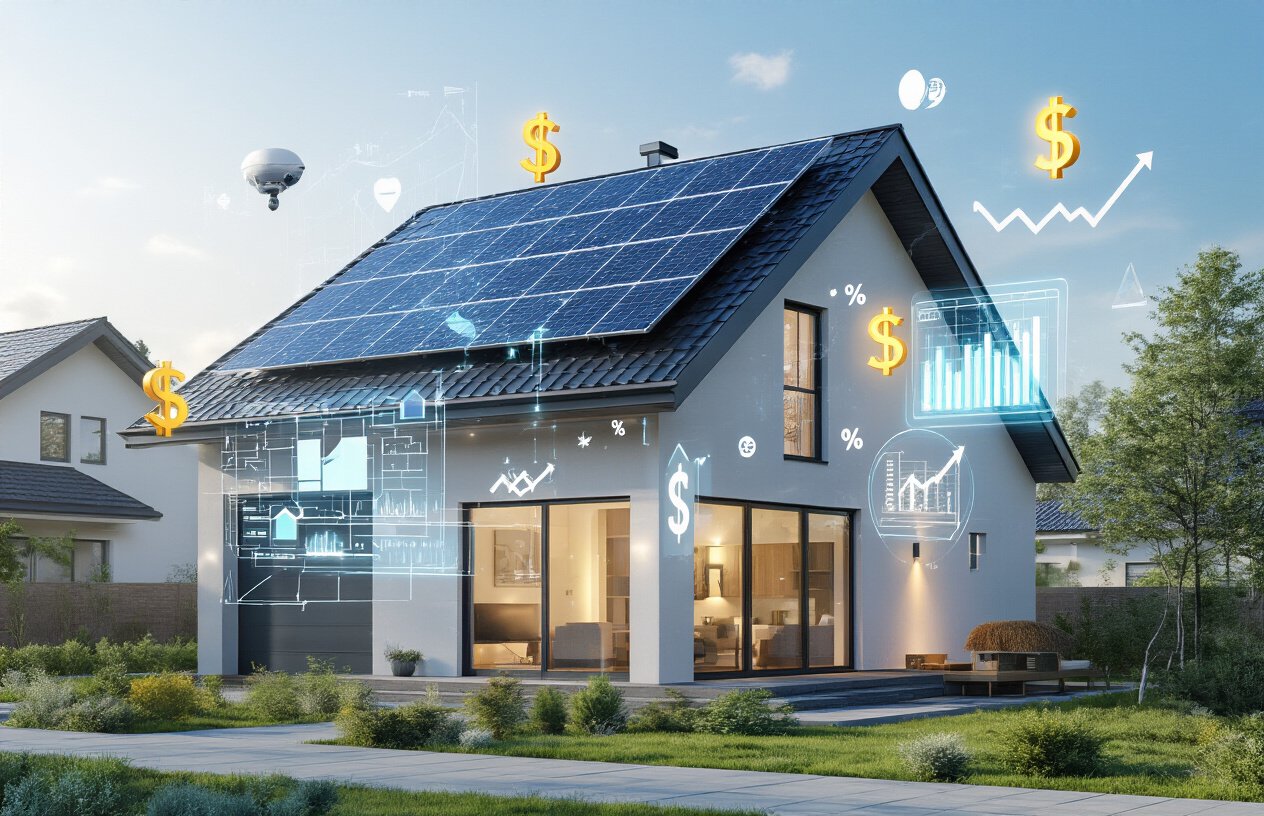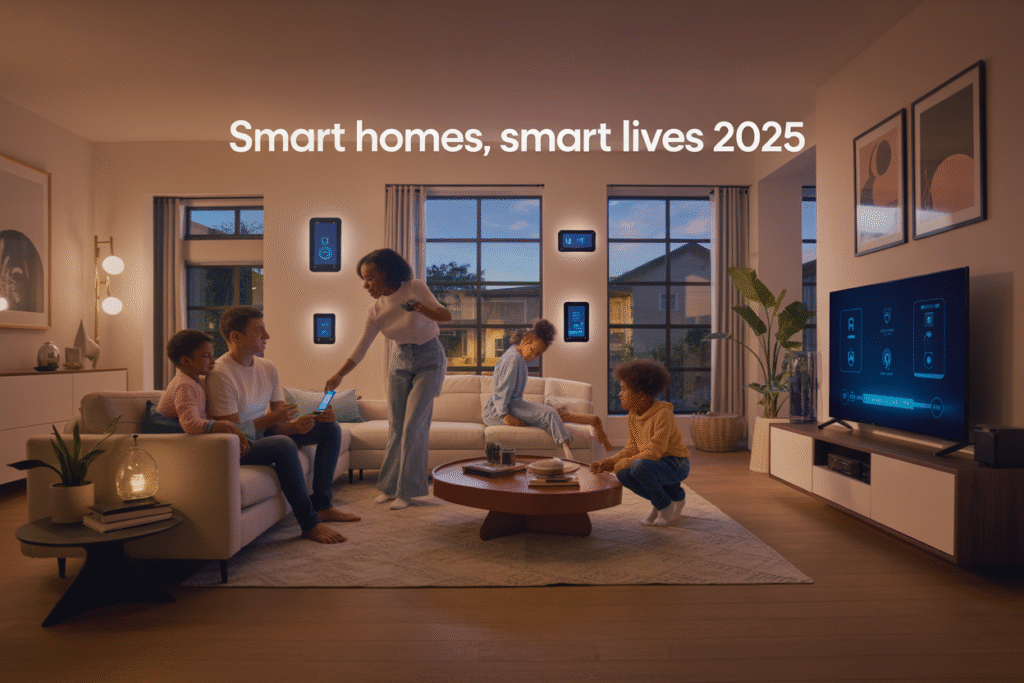Smart homes 2025 are no longer a futuristic dream—they’re reshaping how Americans live, work, and relax at home. If you’re a homeowner curious about home automation technology or considering your first smart home investment, you’re looking at a lifestyle revolution that’s already happening in neighborhoods across the country.
Today’s intelligent home features go way beyond voice-controlled lights and thermostats. We’re talking about homes that learn your routines, anticipate your needs, and adapt to your family’s changing lifestyle automatically.
This guide breaks down what smart living really looks like in 2025. You’ll discover how revolutionary automation technologies are making daily life smoother and more enjoyable. We’ll also dive into the real smart home investment returns you can expect—because these aren’t just cool gadgets, they’re smart financial moves that boost your home’s value. Finally, we’ll tackle the big questions around smart home security privacy that every homeowner should understand before going all-in on connected home devices.
Ready to see how automated living systems could transform your everyday routine? Let’s explore what makes smart homes 2025 the new standard for modern American living.
Revolutionary Home Automation Technologies Transforming Daily Living

AI-Powered Voice Assistants Managing Entire Household Operations
Voice assistants have evolved far beyond simple music playback and weather updates. Today’s smart homes 2025 feature sophisticated AI systems that orchestrate complex household operations with remarkable precision. These advanced platforms learn your daily routines, anticipate needs, and coordinate multiple smart devices simultaneously.
Modern voice assistants now manage intricate tasks like automatically adjusting lighting based on your circadian rhythms, scheduling appliance maintenance, and even ordering groceries when supplies run low. They integrate seamlessly with smart thermostats, security systems, and kitchen appliances to create a truly automated living experience.
The real game-changer lies in their predictive capabilities. Your AI assistant tracks patterns in your behavior and proactively manages your home environment. It might pre-heat your oven when you typically start dinner preparation or gradually dim lights as your usual bedtime approaches.
These systems also excel at energy optimization, automatically switching devices to eco-friendly modes during peak electricity pricing hours. Voice assistants coordinate with smart plugs, lighting systems, and HVAC units to minimize energy consumption without sacrificing comfort.
Predictive Climate Control Systems Reducing Energy Costs by 40%
Home automation technology has revolutionized how we approach heating and cooling, with predictive climate control systems delivering unprecedented energy savings. These intelligent systems analyze weather patterns, occupancy schedules, and home thermal dynamics to optimize temperature management.
Smart thermostats equipped with machine learning algorithms study your preferences and create personalized comfort profiles for different times and seasons. They consider factors like outdoor temperature trends, solar heat gain through windows, and even your smartphone location to adjust settings before you arrive home.
The 40% energy cost reduction comes from several innovative features:
- Zoned temperature control that heats or cools only occupied areas
- Predictive pre-conditioning that gradually adjusts temperatures rather than making dramatic changes
- Weather-responsive programming that anticipates temperature swings
- Integration with renewable energy sources like solar panels for optimal timing
These systems also communicate with other connected home devices to coordinate energy usage. During peak demand periods, they might slightly adjust temperatures while increasing ventilation fan speeds to maintain comfort levels without straining the electrical grid.
Advanced Security Networks Providing Real-Time Threat Detection
Connected home devices now form comprehensive security ecosystems that provide 24/7 monitoring and instant threat assessment. Modern smart home security privacy systems combine multiple detection methods to create layered protection that adapts to emerging threats.
AI-powered cameras distinguish between family members, pets, delivery personnel, and potential intruders using facial recognition and behavioral analysis. These systems learn normal activity patterns and immediately flag unusual movements or sounds, sending real-time alerts to homeowners and security services.
Smart door locks integrate with doorbell cameras, motion sensors, and smartphone apps to create secure entry protocols. Temporary access codes can be generated for service providers, while biometric authentication ensures only authorized individuals gain entry. Window sensors, glass break detectors, and perimeter monitoring create multiple security layers.
The network effect multiplies security effectiveness. When one sensor detects anomalous activity, the entire system activates, recording evidence from multiple angles while simultaneously notifying authorities. Environmental sensors also monitor for fire, carbon monoxide, and water leaks, providing comprehensive household protection.
Seamless Device Integration Creating Effortless User Experiences
The true power of automated living systems emerges when individual smart devices work together as a unified ecosystem. Home automation trends 2025 emphasize interoperability, where lights, appliances, entertainment systems, and security devices communicate through standardized protocols.
Smart hubs serve as central command centers, translating signals between different device manufacturers and creating unified control interfaces. Whether you prefer smartphone apps, voice commands, or wall-mounted control panels, the same intuitive interface manages every connected device in your home.
Scene automation transforms multiple device operations into single commands. A “Good Morning” scene might simultaneously raise blinds, start coffee brewing, display weather information on smart mirrors, and play your preferred news podcast. Evening scenes can lock doors, arm security systems, adjust lighting, and set climate controls with one tap.
The integration extends to entertainment and productivity. Smart TVs coordinate with sound systems and lighting to create immersive viewing experiences, while home office setups automatically adjust lighting, temperature, and acoustics for video conferences. Kitchen appliances share cooking progress with range hoods and timers, ensuring perfectly coordinated meal preparation.
This seamless connectivity eliminates the complexity traditionally associated with technology management, making smart lifestyle benefits accessible to users regardless of their technical expertise.
Enhanced Quality of Life Through Intelligent Home Features

Automated Health Monitoring Systems Promoting Wellness
Smart homes 2025 are revolutionizing personal healthcare with seamless monitoring systems that track your well-being without lifting a finger. These intelligent home features include air quality sensors that automatically adjust ventilation when pollutants spike, smart mirrors that scan for changes in skin tone or posture, and flooring with embedded sensors that detect gait changes or falls.
Sleep tracking has become incredibly sophisticated, with bedroom sensors monitoring heart rate, breathing patterns, and sleep cycles through non-invasive radar technology. Your home learns your sleep habits and automatically adjusts temperature, humidity, and even releases calming scents when it detects restlessness. Some systems can identify early signs of illness by tracking subtle changes in movement patterns or voice tone during daily conversations with smart assistants.
Blood pressure monitoring happens through smart bathroom fixtures, while weight fluctuations are tracked via intelligent scales that sync with your home’s health dashboard. These systems alert you and your healthcare providers to concerning trends before they become serious issues. The data creates personalized wellness recommendations, like suggesting more hydration when sensors detect dehydration markers or recommending specific exercises based on your activity patterns.
Smart Kitchen Appliances Simplifying Meal Preparation
Modern connected home devices are transforming kitchens into culinary command centers that make cooking effortless and enjoyable. Smart refrigerators now inventory your groceries, track expiration dates, and suggest recipes based on available ingredients. They automatically order replacements for items running low and can even accommodate dietary restrictions or health goals.
Intelligent ovens and cooktops take the guesswork out of cooking by using internal cameras and sensors to monitor food temperature and doneness. You can start dinner remotely during your commute, and the oven will adjust cooking times based on your actual arrival time using GPS tracking from your smartphone. Multi-zone induction cooktops communicate with smart cookware to maintain precise temperatures for different dishes simultaneously.
Smart home investment returns become evident in reduced food waste and grocery costs. These systems learn your eating patterns and preferences, creating shopping lists that eliminate impulse purchases and forgotten items. Voice-controlled recipe assistance guides you through complex dishes step-by-step, while smart scales ensure perfect measurements every time. Dishwashers now detect soil levels and adjust cycles accordingly, saving water and energy while ensuring spotless results.
Personalized Lighting Systems Improving Sleep and Productivity
Home automation technology has mastered the art of lighting to enhance both energy levels and rest quality. Circadian rhythm lighting systems automatically adjust color temperature and intensity throughout the day, mimicking natural sunlight patterns to regulate your body’s internal clock. Cool, bright blue-white light energizes you during morning hours, while warm amber tones in the evening signal your brain to prepare for sleep.
Smart lighting responds to your activities and presence, brightening work areas when you sit at your desk and dimming gradually as bedtime approaches. Motion sensors ensure you never stumble through dark hallways, while vacation modes simulate your normal lighting patterns to deter intruders. Some advanced systems even factor in weather conditions, providing brighter illumination on overcast days to combat seasonal mood changes.
Productivity zones can be customized for different tasks – reading lights that reduce eye strain, focused task lighting that enhances concentration, and ambient lighting for relaxation. The system learns your preferences and creates lighting scenes that automatically activate based on your schedule or voice commands. Smart lifestyle benefits extend to reduced eye fatigue, better sleep quality, and improved mood regulation, making your home an environment that actively supports your daily rhythms and activities.
Financial Benefits and Long-Term Investment Returns

Substantial Energy Savings Through Optimized Resource Management
Smart homes 2025 deliver dramatic reductions in energy consumption through intelligent automation systems that learn your habits and optimize usage patterns. Automated HVAC systems adjust temperatures based on occupancy, weather forecasts, and time-of-day preferences, cutting heating and cooling costs by 20-30%. Smart thermostats can save homeowners $131-$145 annually, while comprehensive home automation technology packages often reduce total energy bills by $300-$600 per year.
Smart lighting systems automatically dim or turn off lights in unoccupied rooms, and advanced window treatments adjust throughout the day to maximize natural light while minimizing solar heat gain. Water heaters equipped with smart controls heat water only when needed, and smart irrigation systems use weather data to water lawns and gardens efficiently, reducing water waste by up to 50%.
Connected home devices work together to identify energy-wasting patterns and suggest improvements. Smart outlets can cut phantom power draw from electronics in standby mode, while energy monitoring systems provide real-time feedback that helps homeowners make better consumption choices.
Increased Property Values in Smart Home Markets
Properties equipped with intelligent home features command premium prices in today’s real estate market. Recent studies show homes with comprehensive smart home investment returns averaging 3-5% higher sale prices compared to traditional properties. Millennials and Gen Z buyers specifically seek out connected home devices, making smart-enabled properties sell faster and for better prices.
High-demand features include smart security systems, automated lighting, programmable thermostats, and integrated entertainment systems. Voice-controlled assistants and smart appliances add significant appeal for tech-savvy buyers who view these features as essential rather than luxurious add-ons.
Real estate professionals report that smart home listings generate 25% more inquiries and spend 15% less time on the market. Properties with established smart ecosystems appeal to buyers who want move-in-ready technology without the hassle of researching and installing systems themselves.
Reduced Insurance Premiums for Enhanced Security Features
Insurance companies increasingly reward homeowners who install smart security systems with meaningful premium discounts. Smart smoke detectors, water leak sensors, and security cameras can reduce homeowners insurance costs by 5-15%. Some insurers offer even deeper discounts for comprehensive monitoring systems that alert both homeowners and emergency services.
Water damage prevention systems earn particularly generous discounts since water damage claims represent one of insurance companies’ largest expenses. Smart water shut-off valves and leak detection sensors can prevent thousands in damage, making insurers eager to incentivize their installation.
Security cameras, smart locks, and professional monitoring services demonstrate reduced theft risk, qualifying homeowners for security-related discounts. Many insurance providers now offer specific smart home policies with enhanced coverage options and lower deductibles for properties with qualifying technology.
Lower Maintenance Costs Through Predictive System Alerts
Automated living systems excel at preventing expensive repairs through early detection and predictive maintenance alerts. Smart HVAC systems monitor filter conditions, airflow patterns, and component performance, alerting homeowners to potential issues before they become costly failures. Replacing a $20 filter prevents a $3,000 compressor replacement.
Smart water systems detect pressure changes, temperature fluctuations, and flow irregularities that signal developing problems. Early leak detection prevents water damage that averages $10,000 per incident. Predictive alerts about appliance performance help homeowners schedule maintenance during off-peak pricing periods and avoid emergency repair surcharges.
Home automation trends 2025 include AI-powered systems that learn normal operating parameters and flag deviations immediately. These systems schedule routine maintenance automatically, negotiate service appointments, and even order replacement parts before failures occur, keeping homes running smoothly while minimizing both repair costs and inconvenience.
Privacy and Security Considerations for Modern Smart Homes

Data Protection Strategies for Connected Device Networks
Your smart home collects massive amounts of personal data every day. From when you wake up to how often you open the fridge, these devices create detailed profiles of your daily habits. The key to protecting this information starts with understanding what data each device collects and where it goes.
Create separate network segments for your smart home security privacy systems. Set up a dedicated IoT network that isolates your connected home devices from computers and phones containing sensitive information. This prevents a compromised smart bulb from accessing your work files or banking apps.
Review privacy settings on each device regularly. Many manufacturers default to maximum data collection, but you can often limit what information gets shared. Turn off voice recording storage, disable location tracking for indoor devices, and opt out of data sharing with third parties whenever possible.
Essential Data Protection Checklist:
- Change default passwords on all devices immediately
- Enable two-factor authentication where available
- Update firmware automatically or monthly
- Use strong, unique passwords for each device
- Regularly audit connected devices and remove unused ones
Consider local storage solutions over cloud-based systems when possible. Smart home investment returns include better data control through hubs that process information locally rather than sending everything to remote servers.
Cybersecurity Measures Against Digital Home Invasions
Hackers increasingly target smart homes because many people don’t secure their connected home devices properly. A single vulnerable device can become an entry point for cybercriminals to access your entire network.
Start with your router – the gateway to your digital home. Replace default admin credentials immediately and enable WPA3 encryption. Hide your network name (SSID) and disable WPS, which creates security vulnerabilities. Set up guest networks for visitors so they can’t access your main devices.
Monitor network traffic regularly using router logs or dedicated security software. Unusual data spikes or connections to unknown servers often signal compromised devices. Many routers now include built-in threat detection that blocks suspicious activity automatically.
Network Security Best Practices:
- Install a firewall specifically designed for IoT devices
- Use VPN connections for remote access to home systems
- Disable unnecessary features like microphones when not in use
- Regularly scan for unauthorized devices on your network
- Keep device inventory updated with purchase dates and warranty info
Professional cybersecurity services for homes are becoming more common as home automation technology advances. These services monitor your network 24/7 and can detect threats faster than most homeowners.
Balancing Convenience with Personal Information Safety
Smart homes 2025 will offer incredible convenience, but each automated feature comes with privacy trade-offs. The trick lies in finding your personal comfort level between functionality and data protection.
Voice assistants provide excellent control over automated living systems, but they’re always listening. Create “privacy zones” in bedrooms and home offices where voice devices stay turned off. Use physical buttons or smartphone apps for control in these sensitive areas.
Video doorbells and security cameras enhance safety but can inadvertently record neighbors or delivery personnel. Position cameras to capture only your property and inform visitors about recording. Store footage locally when possible, and delete recordings regularly unless needed for security purposes.
Smart thermostats learn your schedule to optimize energy usage, but this creates detailed patterns of when you’re home or away. Criminals could potentially use this information for break-ins. Configure random schedule variations and avoid posting real-time location updates on social media.
Privacy-Friendly Smart Home Setup:
- Use timers instead of presence sensors where possible
- Choose devices with physical privacy switches
- Read terms of service to understand data usage
- Limit cross-device data sharing
- Set automatic data deletion schedules
The future-proof home technology approach means selecting devices from manufacturers with strong privacy track records. Look for companies that process data locally, offer transparent privacy policies, and provide regular security updates. Your smart lifestyle benefits shouldn’t come at the cost of personal privacy.
Future-Proofing Your Home for the Next Decade

Scalable Smart Home Systems Adapting to Emerging Technologies
Building a truly future-proof home technology means choosing systems that can grow and evolve without requiring complete overhauls. The best smart homes 2025 will feature modular platforms that seamlessly integrate new devices as they hit the market. Think of your smart home as a living ecosystem rather than a fixed installation.
Hub-based systems offer the strongest foundation for scalability. Platforms like Samsung SmartThings, Hubitat, and Home Assistant create a central command center that can communicate with devices across multiple protocols – Zigbee, Z-Wave, WiFi, and Thread. This multi-protocol approach protects your investment when manufacturers shift their technology standards.
Cloud-hybrid architectures provide the perfect balance between connectivity and reliability. While cloud connectivity enables remote access and regular updates, local processing ensures your automated living systems continue functioning even during internet outages. This dual approach becomes increasingly important as we depend more heavily on connected home devices.
Open-source compatibility is your insurance policy against obsolescence. Systems built on open standards can adapt to new technologies without vendor lock-in. When choosing smart home infrastructure, prioritize platforms that support Matter/Thread protocols – the emerging universal language for smart home communication.
Professional Installation vs DIY Smart Home Solutions
The decision between professional installation and DIY implementation depends on your technical comfort level, available time, and system complexity. Each approach offers distinct advantages that can make or break your smart home experience.
Professional Installation Benefits:
- Comprehensive system design and planning
- Proper network infrastructure setup
- Warranty coverage and ongoing support
- Integration of complex systems like security and HVAC
- Time savings and reduced troubleshooting
DIY Advantages:
- Significant cost savings (30-50% less expensive)
- Complete control over device selection
- Learning experience that empowers future upgrades
- Flexibility to implement changes gradually
- No scheduling constraints or service calls
Start with a hybrid approach for the best of both worlds. Have professionals handle the foundational elements – network backbone, electrical work, and complex integrations – while tackling simpler devices like smart lights, plugs, and sensors yourself. This strategy maximizes your budget while ensuring critical systems work flawlessly.
Consider your long-term maintenance capabilities. Professional installations often include service agreements that handle updates and troubleshooting. DIY systems require you to stay current with firmware updates and resolve connectivity issues independently.
Essential Smart Home Features Every American Household Needs
Smart home investment returns start with focusing on high-impact features that deliver immediate value. Skip the gadgets and concentrate on systems that solve real problems and enhance daily living.
Core Automation Systems:
- Programmable thermostats with learning capabilities
- Smart lighting with scheduling and occupancy detection
- Security cameras with mobile alerts and cloud storage
- Smart locks with keyless entry and temporary access codes
- Leak detection sensors for basements and water heaters
Convenience Technologies:
- Voice assistants for hands-free control
- Smart garage door openers with smartphone integration
- Video doorbells with two-way communication
- Automated window coverings for privacy and energy efficiency
- Smart smoke and carbon monoxide detectors
Energy management represents the fastest path to measurable returns. Smart thermostats alone can reduce heating and cooling costs by 10-15% annually. Intelligent lighting systems eliminate energy waste from forgotten lights, while smart power strips prevent phantom power draw from electronics.
Security features provide both peace of mind and insurance premium discounts. Many insurers offer 5-10% discounts for homes equipped with monitored security systems, smart smoke detectors, and water leak sensors.
Integration Timeline and Budget Planning Strategies
Smart home implementation works best as a phased approach rather than an all-at-once transformation. This strategy spreads costs over time while allowing you to learn and optimize each system before adding complexity.
Phase 1 (Months 1-3): Foundation – $500-1,500
- Central hub or smart home platform
- Network infrastructure upgrades
- Basic smart lighting (3-5 rooms)
- Smart thermostat installation
Phase 2 (Months 4-8): Security and Monitoring – $800-2,000
- Smart locks and video doorbell
- Security cameras for key areas
- Smoke and leak detection sensors
- Smart garage door opener
Phase 3 (Months 9-18): Advanced Automation – $1,000-3,000
- Whole-house lighting automation
- Automated window treatments
- Advanced climate zones
- Entertainment system integration
Budget for 10-15% contingency costs to handle unexpected compatibility issues or infrastructure upgrades. Older homes may require electrical work or network improvements that weren’t apparent during initial planning.
Take advantage of seasonal sales and bundle deals from major retailers. Black Friday, Amazon Prime Day, and end-of-year clearances can deliver 20-40% savings on home automation technology. Manufacturer rebates and utility company incentives can offset costs for energy-efficient devices like smart thermostats and LED lighting systems.
Plan for ongoing costs including cloud storage subscriptions, monitoring services, and periodic hardware upgrades. Factor $10-30 monthly for cloud services and $200-500 annually for device replacements or expansions.

Smart homes have become the foundation of modern American living, transforming how we interact with our spaces and manage our daily routines. From voice-activated assistants that control lighting and temperature to advanced security systems that learn our patterns, these technologies are making life more convenient, comfortable, and efficient. The financial benefits are equally compelling – homeowners are seeing reduced energy bills, increased property values, and long-term savings that justify the initial investment.
The shift toward intelligent living isn’t just about gadgets and convenience; it’s about creating homes that adapt to our needs and protect our privacy while doing so. As we look ahead, the homes being equipped today with smart technology will remain relevant and valuable for years to come. Now is the perfect time to start small – perhaps with a smart thermostat or security system – and gradually build your connected home ecosystem. Your future self will thank you for making the move toward smarter, more efficient living.



